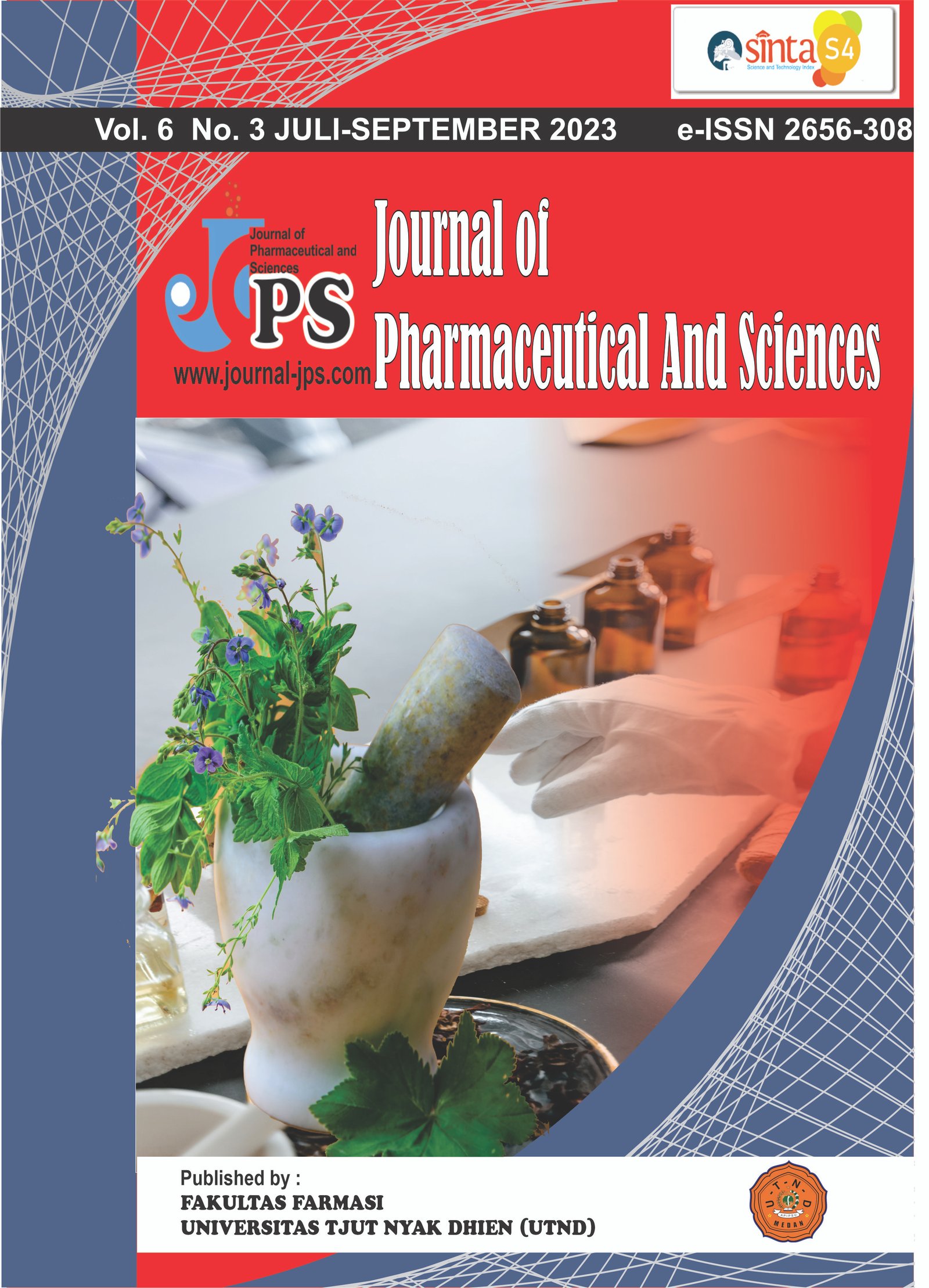Evaluation of Coffee Mistletoe Leaf Ethanol Extract on Burn Healing Activity on White Male Rat
Main Article Content
Page: 1059-1067
Abstract
Burns are injuries that can be caused by heat (fire, hot liquids/fats, hot vapors), radiation, electricity, or chemicals. Coffee mistletoe leaves (Loranthus ferruginous Roxb) are one type of plant that contains secondary metabolite compounds, such as flavonoids, tannins, saponins, alkaloids, and phenolics, which play a role in the burn healing effects. This research was conducted using an experimental research method with a Completely Randomized Design (CRD) and a post-test only control group design approach. A total of 25 rats were divided into five treatment groups for the study. The groups included a positive control group treated with Bioplacenton gel, a negative control group treated with yellow vaseline, and three experimental groups treated with different concentrations of ethanol extract of coffee mistletoe leaves. The concentrations used were 5% (P1), 10% (P2), and 15% (P3). The burn healing activity and hydroxyproline content were observed as outcome measures. The data were presented as mean ± SD and analyzed using one-way ANOVA. Subsequently, Duncan's multiple rank test was performed to determine any significant differences. A significance level of p<0.05 was considered to define statistically significant results. The results of the study showed that ethanol extract of coffee mistletoe leaves has an effect as a burn treatment, with the best concentration found at 15% concentration, which had a healing percentage of 62.5%, although its effectiveness did not exceed that of the positive control group (72,48%). The hydroxyproline content of the coffee mistletoe leaf extract group demonstrated significant difference when compared to control negative groups, especially P1 group (53.62±6.52 μg/mL), and statistically not different with positive control (64.34 ±6.02 μg/mL). For the P2 and P3 groups, the hydroxyproline content were increased but did not reach significant value. Wound-healing activity owing to its richness in various effective chemical compounds present in the extract such as phenolics, saponin, flavonoid and alkaloid. Further investigation is necessary to identify and understand these additional components and their mechanisms of action in the healing process.
Downloads
Article Details

This work is licensed under a Creative Commons Attribution-NonCommercial-ShareAlike 4.0 International License.
References
Ameer, O. Z., Salman, I. M., Quek, K. J., & Asmawi, M. Z. (2015). Loranthus ferrugineus: a Mistletoe from Traditional Uses to Laboratory Bench. Journal of Pharmacopuncture, 8(1), 1–18. https://doi.org/10.3831/KPI.2015.18.001
Carvalho, M. T. B., Araújo-Filho, H. G., Barreto, A. S., Quintans-Júnior, L. J., Quintans, J. S. S., & Barreto, R. S. S. (2021). Wound healing properties of flavonoids: A systematic review highlighting the mechanisms of action. Phytomedicine, 90, 153636. https://doi.org/10.1016/J.PHYMED.2021.153636
Dwivedi, D., Dwivedi, M., Malviya, S., & Singh, V. (2017). Evaluation of wound healing, anti-microbial and antioxidant potential of Pongamia pinnata in wistar rats. Journal of Traditional Chinese Medical Sciences, 7, 79–85. https://doi.org/10.1016/j.jtcme.2015.12.002
Efendi, M. R. (2019). Skrining Aktivitas Antibakteri Fraksi Kelopak Bunga Mussaenda frondosa L. Journal of Pharmaceutical And Sciences, 2(1), 38–44. https://doi.org/10.36490/JOURNAL-JPS.COM.V2I1.18
Efendi, M. R., Rusdi, M. S., & Dinda, A. (2022). Antibacterial activity of ethyl acetate extracts of fungal endophytes isolated from leaf gambir leaves (Uncaria gambir (Hunter) Roxb). Media Farmasi: Jurnal Ilmu Farmasi, 19(1), 17–23. https://doi.org/10.12928/MF.V19I1.20483
Fetse, J., Kyekyeku, J., Dueve, E., & Mensah, K. (2014). Wound Healing Activity of Total Alkaloidal Extract of the Root Bark of Alstonia boonei (Apocynacea). British Journal of Pharmaceutical Research, 4(23), 2642–2652. https://doi.org/10.9734/BJPR/2014/13952
Guimarães, I., Baptista-Silva, S., Pintado, M., & Oliveira, A. L. (2021). Polyphenols: A Promising Avenue in Therapeutic Solutions for Wound Care. Applied Sciences 2021, Vol. 11, Page 1230, 11(3), 1230. https://doi.org/10.3390/APP11031230
Hoeben, A., Landuyt, B., Highley, M. S., Wildiers, H., Van Oosterom, A. T., & De Bruijn, E. A. (2004). Vascular endothelial growth factor and angiogenesis. Pharmacological Reviews, 56(4), 549–580. https://doi.org/10.1124/PR.56.4.3
Jeschke, M. G., van Baar, M. E., Choudhry, M. A., Chung, K. K., Gibran, N. S., & Logsetty, S. (2020). Burn injury. Nature Reviews. Disease Primers, 6(1). https://doi.org/10.1038/S41572-020-0145-5
Jorge, M. P., Madjarof, C., Ruiz, A. L. T. G., Fernandes, A. T., Rodrigues, R. A. F., de Oliveira Sousa, I. M., … de Carvalho, J. E. (2008). Evaluation of wound healing properties of Arrabidaea chica Verlot extract. Journal of Ethnopharmacology, 118(3), 361–366. https://doi.org/10.1016/J.JEP.2008.04.024
Ministry of Health Indonesia. (2017). Indonesian Herbal Pharmacopeia. In Directorate General of Pharmacy and Medical Devices (Second). Jakarta: Directorate General of Pharmacy and Medical Devices.
Rawlings, R. H., Shaw, A., Champion, H. R., Napolitano, L. M., Singer, B., Rhodes, A., … Cannesson, M. (2022). First Degree Burn. Encyclopedia of Intensive Care Medicine, 939–939. https://doi.org/10.1007/978-3-642-00418-6_1610
Talekar, Y. P., Apte, K. G., Paygude, S. V., Tondare, P. R., & Parab, P. B. (2017). Studies on wound healing potential of polyherbal formulation using in vitro and in vivo assays. Journal of Ayurveda and Integrative Medicine, 8(2), 73–81. https://doi.org/10.1016/J.JAIM.2016.11.007
Yulian, M., Safrijal, D., Tarbiyah, F., Uin, K., & Aceh, A.-R. (2018). Uji Aktivitas Antioksidan Daun Benalu Kopi (Loranthus Ferrugineus Roxb.) dengan Metode Dpph (1,1 – Difenil -2- Pikrilhidrazil). Lantanida Journal, 6(2), 192–202. https://doi.org/10.22373/LJ.V6I2.4127
Zahra, A. A., Kadir, F. A., Mahmood, A. A., hadi, A. A. Al, Suzy, S. M., Sabri, S. Z., … Ketuly, K. A. (2011). Acute toxicity study and wound healing potential of Gynura procumbens leaf extract in rats. Journal of Medicinal Plants Research, 5(12), 2551–2558. https://doi.org/10.5897/JMPR.9000042





